Template:Semi-protected
Much of this article relates to the final versions of Middle-earth's history, and as such may contain discrepancies with The Silmarillion. See LOTR:Canon for a discussion. This subject's portrayal in earlier or alternative versions is discussed in the Earlier versions of the legendarium section.
- "This is Nenya, the Ring of Adamant, and I am its keeper."
- —Galadriel to Frodo Baggins
Galadriel was the co-ruler and Lady of Lothlórien alongside her husband, Lord Celeborn - however, neither of them took royal titles, as they only saw themselves as the Guardians of The Golden Wood.
She was the only daughter and youngest child of Finarfin, prince of the Ñoldor and of Eärwen, whose cousin was Lúthien. Her elder brothers were Finrod Felagund, Orodreth, Angrod, and Aegnor.[2] Galadriel was a niece of Fëanor, one of the most important elves of the First Age.
She was one of the greatest of the Eldar in Middle-earth, and surpassed nearly all others in beauty, knowledge, and power. She was also the bearer of Nenya, one of the three Elven rings of power. Tolkien thought of her, along with Gil-galad the Elven-king, as one of the mightiest and fairest of all the Elves left in Middle-earth.
Biography
Years of the Trees
Galadriel while in Aman, by Szilvia Szarvas
Galadriel was born in Valinor during the Years of the Trees, before the First Age had even begun. Much of Galadriel's story is confusing, and there are several distinct tales told about her collected in the Unfinished Tales. According to the older account, used in the published Silmarillion, Galadriel was an eager participant and leader in the rebellion of the Ñoldor and their flight from Valinor due to her desire to one day rule over a patch of Middle-earth herself.
She was eager to see Middle-earth, having heard of it from Fëanor, and wanted to rule a realm of her own. She swore no oaths and was like minded with her cousin Fingon, son of Fingolfin.[3]
However, separated from Fëanor and his kin, she and her people did not take part in the Kinslaying at Alqualondë. They followed Fingolfin instead and crossed the Helcaraxë in the far north.[3]
First Age
Once in Beleriand, she lived nominally with one of her brothers, most likely Finrod, but spent much time at the court of Thingol and Melian in Menegroth, where she arrived in FA 52 and was welcomed because of her family relationship to Thingol's brother Olwë, Galadriel's maternal grandfather. She met Celeborn, a kinsman of Thingol, in Doriath.[4] She also traveled to visit her brother, Finrod, in his realm of Nargothrond multiple times. Her three other brothers were killed during various battles in the First Age.
Galadriel became friends with Melian the Maia, who wanted to know the cause of the exile of the Ñoldor. Galadriel only briefly narrated the story to her, leaving out the death of Finwë, the Kinslaying at Alqualondë, and the burning of the ships at Losgar. She dwelt in Nargothrond with her brother Finrod, and asked him if he would take no wife. But Finrod had taken an oath only for himself, and his beloved had been left in Valinor.[5]
She played a relatively insignificant part in the wars of the First Age, as she thought that defeating Morgoth was beyond the power of the Eldar, and when Morgoth was defeated by the coming of the Valar out of the West she, having played no part in the Kinslaying, was offered safe return to Valinor. But being prideful, she chose to remain in Middle-earth.[6]
Second Age
Celeborn and Galadriel traveled first to Lindon, where they ruled over a group of Elves as a fiefdom under Gil-galad. Sometime later, they had a daughter, Celebrían. They moved eastward and established the realm of Eregion, or Hollin, which they ruled under Gil-galad, the High King of the Ñoldor. Eregion, to the west of the Misty Mountains near Moria, was a prosperous kingdom during this time, and had open trade with the Dwarves. Also, during this time, they made contact with a Nandorin settlement in the valley of the Anduin, later to be known as Lothlórien. Subsequently, while Celebrimbor now ruled over Eregion, they left Eregion by way of the mines of Khazad-dûm and became the Lord and Lady of Lothlórien.
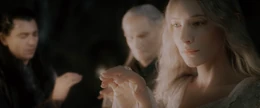
Galadriel, Gil-galad, and Cirdan receive the Three Rings of Power.
During the Second Age, the Maia Annatar, the "Lord of Gifts", guided Celebrimbor and the other Ñoldor of Eregion in the creation of the Rings of Power. Galadriel took an immediate distrust to Annatar, and it later turned out that this mistrust was justified, as he was finally revealed to be Sauron. It was she who counseled Celebrimbor in the hiding of the rings, and when Eregion was attacked, Galadriel was entrusted with one of the Three Rings of the Elves. Her ring was Nenya, the Ring of Water.
Conscious of Sauron's power, and wishing to thwart it, she did not openly use the powers of her ring as long as the One Ring was in Sauron's hands. However, during the Third Age, when the One Ring was lost, she put it to good use protecting the borders of her realm, for the powers of her ring were protection, preservation, and concealment from evil.[7]
Third Age
Through Celebrían's wedding to Elrond, Galadriel was the grandmother of Elladan, Elrohir, and Arwen.
The tales tell little of Galadriel or of Celeborn during many centuries in the Third Age, but after the formation of the White Council in TA 2463 she put forth her might in opposition of Sauron. She played a pivotal role in the formation of the Council, though her counsel to put Gandalf at its head was not followed.[7] After Sauron was ousted from his fortress of Dol Guldur, Lórien kept vigilance over the region until the time of the War of the Ring.
War of the Ring

Galadriel pours water into her Mirror.
During the War of the Ring, Galadriel hosted the Fellowship of the Ring after their escape from the mines of Moria.
Once in Caras Galadhon, Galadriel allowed Frodo and Sam to peer into the Mirror of Galadriel, enabling them to glimpse possible events of the future. She, in turn, was tested when Frodo Baggins later offered to place the One Ring in her keeping. To illustrate what would happen if she accepted, she presented an image of herself corrupted by the ring, declaring, "In place of the Dark Lord you will set up a Queen. And I shall not be dark, but beautiful and terrible as the Morning and the Night! Fair as the Sea and the Sun and the Snow upon the Mountain! Dreadful as the Storm and the Lightning! Stronger than the foundations of the earth. All shall love me and despair!" In the movie, what she says is different, which is: "In place of a Dark Lord, you would have a queen! Not dark, but beautiful and terrible as the dawn! Treacherous as the sea! Stronger than the foundations of the earth! All shall love me, and despair!"
Then swiftly she returned to her original form, seemingly smaller and frailer than before, declaring, "I pass the test," refusing the Ring and accepting the fate of diminishing (as the time of the Dominion of Men had come), and returning at last to Valinor. As the Fellowship departed, she gave each member a gift and an Elven cloak, and outfitted the party with boats and supplies. Gimli, in particular, was touched by Galadriel's lordliness and beauty, and asks for one strand of her golden hair as an heirloom of his house; she generously gave him three, which he later set in an impregnable crystal.
Apart from the strands of hair given to Gimli, she gave a Mallorn seed and a small box of earth from her garden to Samwise Gamgee; a green stone set in silver to Aragorn, along with a scabbard for his sword; and a belt each to Boromir, Merry, and Pippin. To Legolas she gave a long, stout bow of the Galadhrim. To Frodo she gave a magical phial, which captured the light of Eärendil's star, without which Frodo and Sam would have been unable to pass through Shelob's lair to complete their quest. After the departure of the Fellowship, Galadriel acted to ensure the success of the quest. It was she who summoned Gwaihir to rescue Gandalf off the peak of Celebdil, and it was she who nursed him back to health, dressing him in white, symbolizing his status as the new leader of the order.
Later, she sent word to Aragorn about the Paths of the Dead, and messages to the Rangers of the North asking for their aid in the War. As Sauron put forth all his power during the end of the War of the Ring, he was aware of the threat of the Elves and their ancient potency, so he sent armies to besiege many of their settlements in the North while simultaneously assailing the major cities of Men and Dwarves. Lórien itself was assaulted three times, but the armies of Dol Guldur were driven back due to the courage of the Elves and the power of Galadriel's Ring.
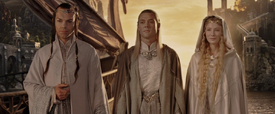
Galadriel, her husband Celeborn, and Elrond about to leave for Valinor
It is said that the power of her Ring could not be overcome unless Sauron himself would come to do battle. After the fall of Sauron she, with Thranduil of Mirkwood and their elven allies, crossed the Anduin into Dol Guldur, where they tore down its walls and laid bare its pits. She then traveled to Minas Tirith for the wedding of King Aragorn and Lady Arwen, and continued living in Lórien until TA 3021 when she traveled to the Grey Havens and, with the remaining Ring-bearers, took a ship and returned at last to the Undying Lands whence she had come so long ago.[8][9]
Character
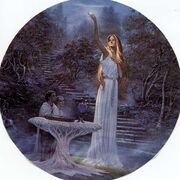
Galadriel shows her mirror before Hobbits.
The Lady Galadriel - "Lady of Light" - grandmother of Lady Arwen, is an Elven Queen of extraordinary beauty, with her timeless features and golden river of hair.
Galadriel was highly praised for her beauty, particularly that of her hair, which was a deep and radiant gold, shot with silver. It was said by the elves of Tirion to have ensnared the light of the two trees, Telperion and Laurelin, and possibly to have inspired the creation of the Silmarils by Fëanor. She was also the tallest of elf-women, standing at around 6 feet 4 inches, or 193 centimeters. Because of her wisdom and power, she had very important roles throughout the history of Middle-earth, especially during her time in Eregion and during the War of the Ring. She had a penchant for dressing in the purest white.
She was known, especially in her younger days, as being quite prideful. However, by the end of the Third Age, that pride had been tempered a great deal by age.
[...] and she grew to be tall beyond the measure even of the women of the Noldor; she was strong of body, mind, and will [...] Even among the Eldar she was accounted beautiful, and her hair was held a marvel unmatched. It was golden like the hair of her father and of her foremother Indis, but richer and more radiant, for its gold was touched by some memory of the starlike silver of her mother; and the Eldar said that the light of the Two Trees, Laurelin and Telperion, had been snared in her tresses.
—Unfinished Tales, "The History of Galadriel and Celeborn"
Regarding her decision to remain in Middle-earth, a passage says:
After the overthrow of Morgoth at the end of the First Age a ban was set upon her return, and she had replied proudly that she had no wish to do so.
—The Road Goes Ever On [note 1]
Powers
She is, however, no mere fey being, but a lady of great power. She bears one of the Great Rings - Nenya - the Ring of Adamant, and with the One Ring in her grasp as well, she would be a mighty match for the Dark Lord Sauron.
Galadriel possessed a tremendous amount of magical powers, and was said to be the greatest of the Ñoldor after Fëanor.
When she still lived in the Undying Lands, she had been a pupil of Yavanna and Aulë, and she later became a friend of Melian the Maia. Hence, it can be deduced that she had learned her powers from these three illustrious personages, though the nature of her magic is still not well-understood.
The vast majority of Galadriel's powers stemmed from the legendary artifact she controlled: Nenya, the Ring of Water. In some tales, she was also depicted with the powers of communicating over vast distances, predicting the future, and even cloaking her mind from other tremendously powerful beings (she once stated that Sauron could not perceive her mind, though she could perceive his). It is also possible that her powers of divination were either derived from or accentuated by her mirror, which could reveal events of the past, present, and future.
However, due to her incredibly enigmatic nature, even the immensely skillful Saruman and an Elf as perceptive as Elrond found it difficult to understand her powers, and they were such to bring doubt to the minds of the non-Elven inhabitants of Middle-earth. Whatever they might have been, it must still be noted that Galadriel had used them for good: protecting Lórien from any attack (it was said that only Sauron himself could have overcome this protection), and destroying Dol Guldur (a fortress whose power was multiplied by Sauron's magic). Last but not least, Galadriel was also skilled in ósanwe (the ability to communicate with others through thoughts): after the destruction of the One Ring, Galadriel communicated mentally with Elrond and Gandalf on their return journey from Minas Tirith.[10]
Besides her magical powers, Galadriel was also extremely wise and intelligent: she was one of the very few who were not fooled by Sauron in the Second Age, and therefore suggested to Celebrimbor to hide the Three Rings. She also refrained from openly using the powers of Nenya while the One Ring was in Sauron's possession, and only did so after the One Ring was lost (for it was only then that it was safe enough for her to do so). When Frodo offered her the One Ring, Galadriel managed to reject the undeniable temptation, for she was wise enough to know that, though she might start off with good intentions with the One Ring in her possession, she would only become a tyrant as terrible as Sauron in the end. This could be viewed as a testament to her excellent understanding of the seductive nature of power, as well as her awareness of her own personal limitations.
Trivia
- Galadriel is the last child of Finarfin, and additionally, the last remaining grandchild of Finwë (with the possible exception of Maglor).
Etymology
Galadriel was originally named Artanis ("noble woman") which was her Father-name and Nerwen ("man-maiden"), which was her Mother-name (referring to her height and strength). Galadriel is the Sindarinized version of Telerin Quenya Alatáriel, the name given to her by her lover Celeborn, meaning "maiden crowned with a garland of bright radiance", which referred to her hair.
The name Galadhriel was used outside Lórien by the people who did not know the ancient days and Galadriel's history, confusing her name with the Elvish word galadh ("tree") and the name of the Galadhrim, the people of Lórien.[9]
Names and Titles
She is referred to as The Lady of Lórien, Lady of Light, The Lady of the Galadhrim, or The Lady of the Wood interchangeably. Within the realm of Lothlórien, she was referred to as simply Lady Galadriel or The Lady.
When she and Celeborn were being referred to collectively, they were known as The Lord and Lady.
House of Finarfin
| Finwë |
| Indis | |||||||||||||||||||||||||||||||||||||||||||||||||||||||||||||||||||||||||||||||||||||||||||||||||
|
|
|
|
|
|
| ||||||||||||||||||||||||||||||||||||||||||||||||||||||||||||||||||||||||||||||||||||||||||||||
| Fingolfin |
| Finarfin |
| Eärwen | |||||||||||||||||||||||||||||||||||||||||||||||||||||||||||||||||||||||||||||||||||||||||||||||
|
|
|
|
|
|
|
|
|
|
|
|
|
|
|
|
|
|
| ||||||||||||||||||||||||||||||||||||||||||||||||||||||||||||||||||||||||||||||||||
| Finrod |
| Angrod |
| Eðellos |
| Aegnor |
| Galadriel |
| Celeborn | |||||||||||||||||||||||||||||||||||||||||||||||||||||||||||||||||||||||||||||||||||||||||
|
|
|
|
|
|
|
|
|
|
|
|
|
|
|
|
|
|
|
|
| ||||||||||||||||||||||||||||||||||||||||||||||||||||||||||||||||||||||||||||||||
|
|
|
|
|
|
| Orodreth |
|
|
|
|
|
|
|
|
| Celebrían | |||||||||||||||||||||||||||||||||||||||||||||||||||||||||||||||||||||||||||||||||||
|
|
|
|
|
|
|
|
|
|
|
| |||||||||||||||||||||||||||||||||||||||||||||||||||||||||||||||||||||||||||||||||||||||||
|
|
|
| Finduilas |
|
|
| Gil-galad | ||||||||||||||||||||||||||||||||||||||||||||||||||||||||||||||||||||||||||||||||||||||||||||
Appearances
In the books
- The Fellowship of the Ring (novel)
- The Return of the King (novel)
- The Silmarillion: Quenta Silmarillion
- Unfinished Tales: The History of Galadriel and Celeborn
In the movies
- An Unexpected Journey
- The Desolation of Smaug
- The Battle of the Five Armies
- The Fellowship of the Ring
- The Two Towers
- The Return of the King
Portrayal in adaptations
Bakshi's Lord of the Rings

Galadriel in Ralph Bakshi's 1978 adaptation.
In Ralph Bakshi's 1978 Lord of the Rings, Galadriel is voiced by Scottish character actress Annette Crosbie.
Lord of the Rings film trilogy
- "Even the smallest person can change the course of the future."
- —Galadriel to Frodo Baggins
Galadriel is portrayed by Cate Blanchett in Peter Jackson's film trilogy. She appears in all three films as a supporting character.
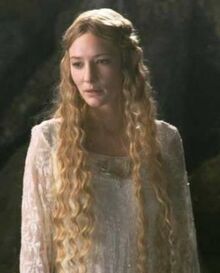
The Lady Galadriel as portrayed by Cate Blanchett
Galadriel narrates the opening prologue to The Fellowship of the Ring, describing the War of the Ring and the initial defeat of Sauron. She is shown receiving one of the elven Rings of Power. Galadriel appears in person later when the Fellowship arrive in Lórien, greeting them alongside her husband Celeborn. She speaks telepathically with Frodo and leads him to her mirror, in which he sees a vision of Sauron's victory. Galadriel warns Frodo that Boromir will try and take the One Ring, upon which Frodo offers The Ring to her. In that moment, Galadriel herself is tempted by the Ring, but she is able to overcome the temptation and "pass the test." She gives Frodo a phial of light when the Fellowship departs Lothlórien.

"In place of a Dark Lord you would have a Queen!"
In the extended edition, Galadriel and Celeborn give the other members of the Fellowship various gifts as well. Besides Frodo and Sam, she gave Merry and Pippin an Elven dagger, Aragorn a curved Elvish hunting knife, Legolas a Bow of the Galadhrim and three strands of Galadriel's hair was given to Gimli.
In The Two Towers, Galadriel appears in a single scene, warning Elrond telepathically that the One Ring is tempting Faramir. She then urges him to send aid to the people of Rohan at Helm's Deep. Strangely, the elves that do arrive at Helm's Deep under Haldir are from Lothlórien, not Rivendell. Although there is mention of osanwe ("thought speech") in Tolkien's writings, Galadriel's scenes from The Two Towers have no direct counterparts in the novels.
In The Return of the King, Galadriel appears in a vision to Frodo near Cirith Ungol, urging him to continue his quest. She also appears at the very end of the film alongside Elrond and Celeborn at the Grey Havens. She departs with them, Gandalf, Frodo, and Bilbo to Valinor.
The Hobbit film trilogy
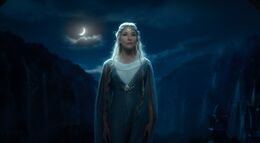
Galadriel in The Hobbit: An Unexpected Journey
Galadriel's role in Jackson's The Hobbit film trilogy is entirely invented for the adaptation, as she does not appear in the original novel. She appears in all three films as a supporting character.
Galadriel first appears in An Unexpected Journey at a meeting of the White Council alongside Elrond, Gandalf, and Saruman. She believes Gandalf when he claims that the Necromancer is becoming a bigger threat and that something must be done with Dol Guldur.
In The Desolation of Smaug, Galadriel telepathically encourages Gandalf to investigate the tombs of the Nine in the High Fells and to confront the Necromancer.
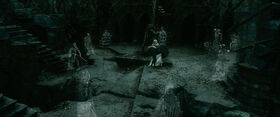
Galadriel aiding a wounded Gandalf in Dol Guldur, surrounded by The Nine
In The Battle of the Five Armies, Galadriel rescues Gandalf from Dol Guldur. Initially, it seems that she has come alone; she defeats an orc with a blast of magic from Nenya. However, she is quickly cornered by the spectral forms of the Nazgûl as the disembodied voice of Sauron begins taunting her in the Black Speech. The Dark Lord mocks the Elf Queen for being alone in the shadow, a singular light in the dark.
However, Galadriel reveals that Saruman and Elrond have accompanied her to Dol Guldur, and the two battle the Ringwraiths while Galadriel attempts to heal Gandalf with a kiss, an action which drains her energy. Radagast arrives to take Gandalf away, and Galadriel resists Gandalf's plea to have her join him. After the Ringwraiths are defeated, Sauron himself manifests and restores the Nazgûl as he bears down on the White Council, threatening them with the fall of the West and the rise of Angmar. While Saruman and Elrond recoil in horror in the presence of the Dark Lord, Galadriel rises in her darker ethereal form to challenge Sauron with the Light of Eärendil.
She easily overpowers the Nazgûl and casts them away as her and Sauron engage in a duel of wills with the latter trying to assert his power. Galadriel, however, proves herself unyielding and declares Sauron as "Nameless, Faceless, and Formless" and demands that he returns to the Void form whence he came. Ultimately Galadriel overpowers Sauron, who is flung into the East as an orb of fire. The encounter saps Galadriel's energy, however, and Saruman instructs her to retreat to Lórien while he promises to handle the threat of Sauron himself.
Radio series
Galadriel was voiced by Marian Diamond in the BBC's The Lord of the Rings (1981 radio series).
Video games
- In The Lord of the Rings: Battle for Middle-earth, Galadriel appears as one of the ring heroes, making her one of the two most powerful units in the game. She has the appearance of her corrupted image in Jackson´s films. She fights using magic which can swipe dozens of units in a single hit. Her power was to summon a tornado as the one she used to destroy Dol Guldur. (See Galadriel at The Wiki for Middle-earth)
- Galadriel also appears in The Lord of the Rings Online, at Caras Galadhon.
In popular culture
The name Galadriel has moved outside of Tolkien's work and into the wider world; parents occasionally give it to their daughters, and at least one high-end shop has adopted it as their own. The Led Zeppelin songs Stairway to Heaven and The Battle of Evermore contain many references to Galadriel. The band Barclay James Harvest also wrote a song named "Galadriel." Galadriel was the given name of the main character in the Katherine Paterson novel The Great Gilly Hopkins. In the novel Panic, there are a group of computer hackers known simply as Galadriel Jones and the elves. Since Elder Scrolls V: Skyrim was released, the elven names of Galadriel and Legolas, and Elrond were often used by fans to name their characters.
Voice dubbing actors
| Foreign Language | Voice dubbing artist |
|---|---|
| Spanish (Latin America) | Gabriela Gómez (The Lord of the Rings & The Hobbit) Irina Índigo (The Lord of the Rings re-dubbing) Verónica López Treviño (The Hobbit: The Battle of the Five Armies) |
| Spanish (Spain) | Nuria Mediavilla |
| Portuguese (Brazil) (Television/DVD) | Neuza Azevedo / Miriam Ficher (The Hobbit trilogy) |
| German | Dörte Lyssewski |
| Italian (Italy) | Cristiana Lionello |
| Japanese | Tomoko Shiota |
| French (France) | Déborah Perret |
| Polish | Danuta Stenka (The Hobbit trilogy) |
| Czech Republic | Simona Postlerová |
| Slovak | Daniela Kuffelová (The Lord of the Rings)
Dagmar Sanitrová (The Hobbit) |
| Turkish | Özden Ayyıldız |
Translations around the world
| Foreign Language | Translated name |
|---|---|
| Amharic | ገላደልኤል |
| Arabic | جلادريل |
| Armenian | Գալադրիել |
| Belarusian Cyrillic | Галадрыэль |
| Bengali | গ্যালাড্রিয়েল |
| Bulgarian Cyrillic | Галадриел |
| Catalan | Galàdriel |
| Chinese (Hong Kong) | 凱蘭崔爾 |
| Georgian | გალადრიელი |
| Greek | Γαλαδριελ |
| Gujarati | ગૅલાડ્રિયેલ |
| Hebrew | גלדריאל |
| Hindi | ङलद्रिएल |
| Japanese | ガラドリエル |
| Kannada | ಗಲಾಡ್ರಿಯಲ್ |
| Kazakh | Галадриэль (Cyrillic) Galadrïél (Latin) |
| Korean | 갈라드리엘 |
| Kyrgyz Cyrillic | Галадриэл |
| Macedonian Cyrillic | Галадриел |
| Marathi | गॅलाड्रीएल |
| Mongolian Cyrillic | Галадриел |
| Nepalese | गालाद्रियल |
| Russian | Галадриэль |
| Pashto | عالادریېل ? |
| Persian | گالادریل |
| Polish | Galadriela |
| Punjabi | ਗਲਾਡ੍ਰੀਏਲ |
| Sanskrit | ङलद्रिएल् |
| Serbian | Галадријела (Cyrillic) Galadrijela (Latin) |
| Serbo-Croatian | Galadrijela |
| Sinhalese | ගලද්රියෙල් |
| Slovak | Alatáriel |
| Tajik Cyrillic | Галадриел |
| Tamil | கலத்ரிஎல் |
| Telugu | గాలడ్రిల్ |
| Thai | กาลาเดรียล |
| Ukrainian Cyrillic | Ґаладріель |
| Urdu | گالدریل |
| Uzbek | Галадриел (Cyrillic) Galadriyel (Latin) |
| Yiddish | גאַלאַדריעל |
| Lady of Lothlórien | ||
| Preceded by Amroth (As King of Lórien) |
Galadriel | Succeeded by None, sailed to the Undying Lands |
| Mid-Third Age - September 29, 3021 | ||
| People: Faramir · Sauron · Witch-king of Angmar · Gollum · Elrond · Frodo Baggins · Samwise Gamgee · Meriadoc Brandybuck · Peregrin Took · Gandalf · Aragorn II · Legolas · Gimli · Boromir · Galadriel · Elves · Hobbits Locations: Middle-earth · Gondor · Mordor · Rohan Other: Mithril · Middle-earth Strategy Battle Game · The Fellowship of the Ring: Being the First Part of The Lord of the Rings · Works inspired by J. R. R. Tolkien · The Lord of the Rings · The Lord of the Rings (1978 film) · Ainulindalë · Tolkien vs. Jackson · Tengwar · Quenya |
References
- ↑ The History of Middle-earth, Vol. X: Morgoth's Ring, The Annals of Aman
- ↑ The Silmarillion, Quenta Silmarillion, Chapter V: "Of Eldamar and the Princes of the Eldalië"
- ↑ 3.0 3.1 The Silmarillion, Quenta Silmarillion, Chapter IX: "Of the Flight of the Noldor" Cite error: Invalid
<ref>tag; name "flight" defined multiple times with different content - ↑ The Silmarillion, Quenta Silmarillion, Chapter XIII: "Of the Return of the Ñoldor"
- ↑ The Silmarillion, Quenta Silmarillion, Chapter XV: "Of the Ñoldor in Beleriand"
- ↑ The Silmarillion, Quenta Silmarillion, Chapter XXIV: "Of the Voyage of Eärendil and the War of Wrath"
- ↑ 7.0 7.1 Unfinished Tales, Part Two, Chapter IV: "The History of Galadriel and Celeborn" Cite error: Invalid
<ref>tag; name "Unfinished" defined multiple times with different content - ↑ The Lord of the Rings
- ↑ 9.0 9.1 The Complete Guide to Middle-earth Cite error: Invalid
<ref>tag; name "Complete" defined multiple times with different content - ↑ The Lord of the Rings, The Return of the King, Book Six, Chapter VI: "Many Partings"
Notes
- ↑ This passage is also mentioned in the Unfinished Tales, The History of Galadriel and Celeborn



